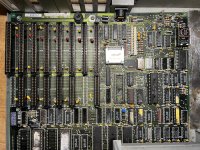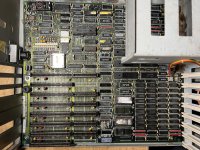Wobblestone
Member
- Joined
- Jul 22, 2023
- Messages
- 29
Hi,
this is not a request for help; I just want to document my repair of a Commodore PC40-40. It seems that the mainboard is quite rare and maybe this thread helps somebody else to repair his machine.
I did not find much information about that machine and board. There are no videos on Youtube. Just a couple of threads here and there showing pictures. But no repair threads.
As I purchased this machine it came complete with a graphics card (VGA with a Trident RVGA 8800CS and 512kB Video RAM), a controller card WD 1003-WA2, a random serial/parallel card and a 5.25" floppy drive and a harddrive Hitachi K521-5 with 40MB. The machine has 1 MB or RAM == 4 banks with 41256.
It was not working as I received it, and it was the dirtiest machine I've ever bought.
After disassembling it, I washed the mainboard and then everything else. The PSU was dead. The fuse was blown. I replaced it, but it instantly got destroyed again. No wonder, since the main switching transistor - a BUV48A was completely shorted. I ordered one and I'm still waiting for it.
I continued with the mainboard itself, which I powered with a modern ATX PSU with an adapter cable. The mainboard was completely dead. It has also 2 ROMs like the NCR, which I repaired recently.
In order to diagnose the mainboard, since it's one of the clones of the IBM 5170 with 80286 and 2 ROMS, I used again the Landmark/Supersoft ROMs:
Put Landmark U27 into U82 of PC/900-2
and
Landmark U47 into U80 of PC/900-2
But no change. The machine remained dead....
....until I poked around with my oscilloscope. Suddenly I got a picture, but the machine stopped at the memory check.
Ok, time to check the RAMs. The first two banks were socketed. Checking the chips revealed 3 dead ICs. I did not check the second and third bank.
The machine still started up only very rarely.
I began to remove ICs from their sockets, putting Deoxit in the socket and so on. That did not help at all....
.... until I removed the CPU itself from its socket.
I cleaned the socket and the CPU and finally the machine booted up and worked perfectly fine.
I can't explain the behavior completely. But maybe poking with the oscilloscope bent the board a little, which closed some contacts within the CPU-socket and that brought the machine back to life. Maybe...
The graphics card was tested in a known good mainboard and it worked out of the box, as well as the controller card.
Surprisingly even the harddisk worked. I just formatted it using Spinrite and Speedstor and installed MS-DOS 6.22.
Only the 5.25" floppy was and is still dead. Most cables were completely rotten. As I tried to repair them, I completely destroyed the cables for the stepper motor of the read/write head.
this is not a request for help; I just want to document my repair of a Commodore PC40-40. It seems that the mainboard is quite rare and maybe this thread helps somebody else to repair his machine.
I did not find much information about that machine and board. There are no videos on Youtube. Just a couple of threads here and there showing pictures. But no repair threads.
As I purchased this machine it came complete with a graphics card (VGA with a Trident RVGA 8800CS and 512kB Video RAM), a controller card WD 1003-WA2, a random serial/parallel card and a 5.25" floppy drive and a harddrive Hitachi K521-5 with 40MB. The machine has 1 MB or RAM == 4 banks with 41256.
It was not working as I received it, and it was the dirtiest machine I've ever bought.
After disassembling it, I washed the mainboard and then everything else. The PSU was dead. The fuse was blown. I replaced it, but it instantly got destroyed again. No wonder, since the main switching transistor - a BUV48A was completely shorted. I ordered one and I'm still waiting for it.
I continued with the mainboard itself, which I powered with a modern ATX PSU with an adapter cable. The mainboard was completely dead. It has also 2 ROMs like the NCR, which I repaired recently.
In order to diagnose the mainboard, since it's one of the clones of the IBM 5170 with 80286 and 2 ROMS, I used again the Landmark/Supersoft ROMs:
Put Landmark U27 into U82 of PC/900-2
and
Landmark U47 into U80 of PC/900-2
But no change. The machine remained dead....
....until I poked around with my oscilloscope. Suddenly I got a picture, but the machine stopped at the memory check.
Ok, time to check the RAMs. The first two banks were socketed. Checking the chips revealed 3 dead ICs. I did not check the second and third bank.
The machine still started up only very rarely.
I began to remove ICs from their sockets, putting Deoxit in the socket and so on. That did not help at all....
.... until I removed the CPU itself from its socket.
I cleaned the socket and the CPU and finally the machine booted up and worked perfectly fine.
I can't explain the behavior completely. But maybe poking with the oscilloscope bent the board a little, which closed some contacts within the CPU-socket and that brought the machine back to life. Maybe...
The graphics card was tested in a known good mainboard and it worked out of the box, as well as the controller card.
Surprisingly even the harddisk worked. I just formatted it using Spinrite and Speedstor and installed MS-DOS 6.22.
Only the 5.25" floppy was and is still dead. Most cables were completely rotten. As I tried to repair them, I completely destroyed the cables for the stepper motor of the read/write head.


